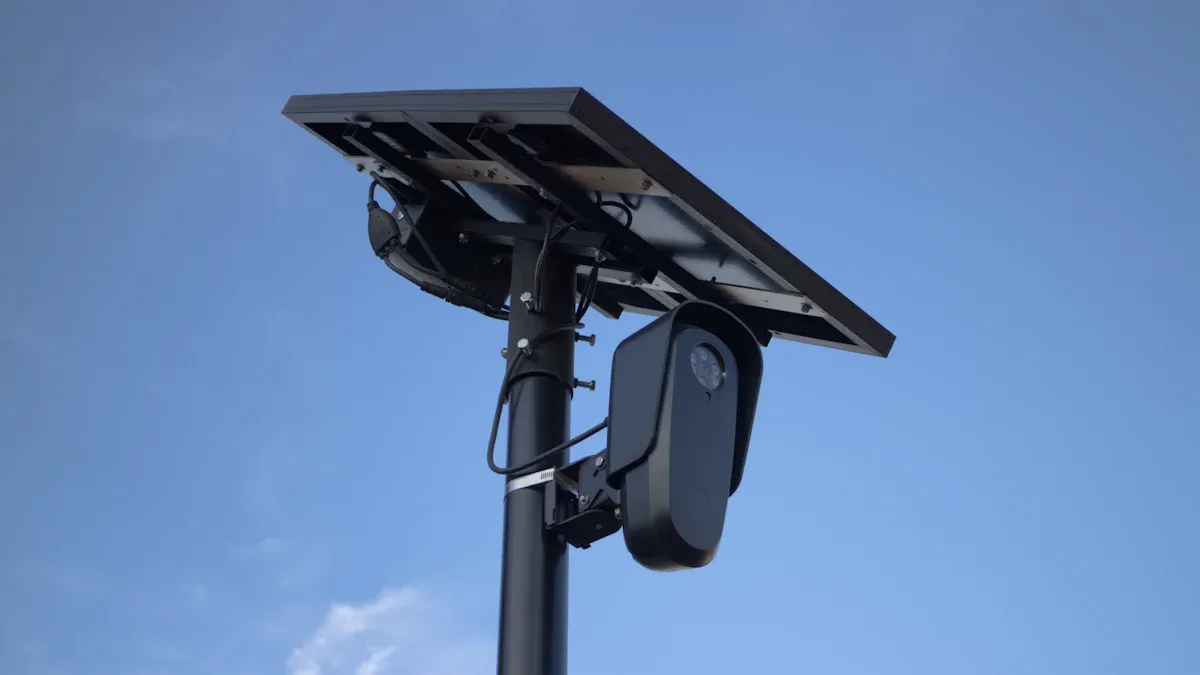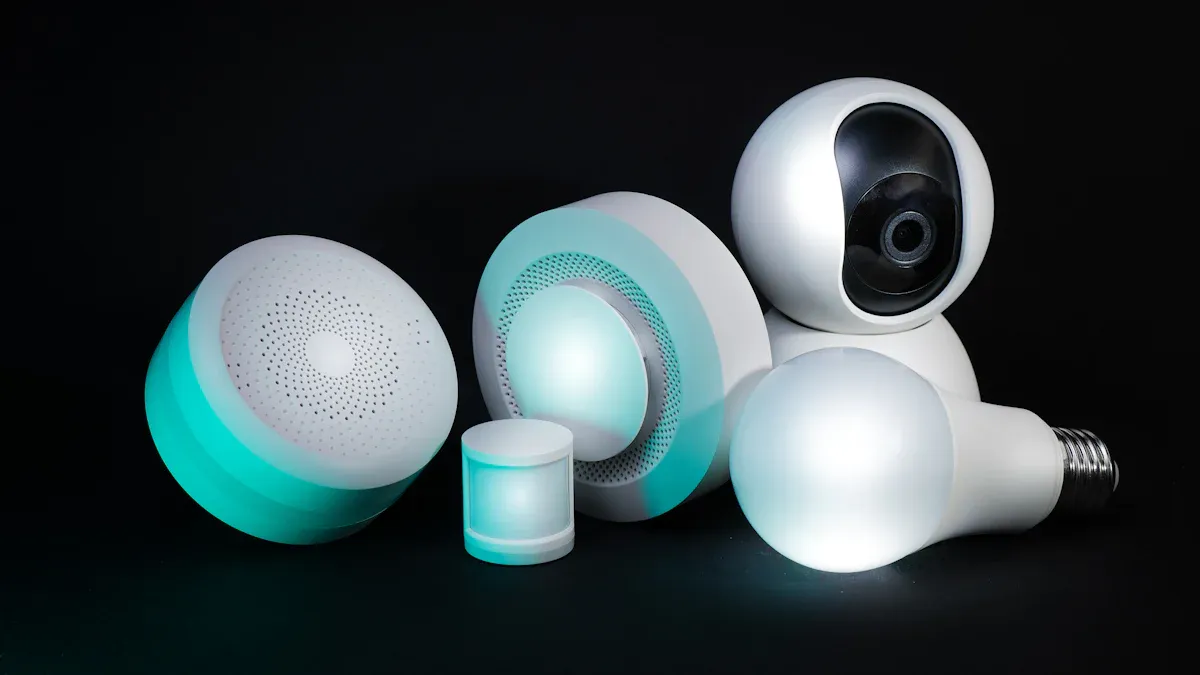
You can save up to $200 each year on energy just by switching to a solar light with a 120° detection angle.
- Many customers love how easy it is to install, how bright it shines, and how well it detects motion.
- People say it stands up to all kinds of weather and helps keep homes safe.
Key Takeaways
- Switching to a solar security light with a 120° detection angle saves you up to $200 a year on energy bills while providing wide motion detection for better home safety.
- Installation is quick and simple with no wiring needed; just pick a sunny spot, mount the light, and enjoy bright, reliable lighting that works in all weather.
- These solar lights offer strong, weather-resistant designs and smart motion sensors that turn on only when needed, giving you peace of mind and low maintenance costs.
Solar Light Customer Experience

Initial Expectations
When you first think about adding a solar light to your home, you probably hope for a few things. You want it to be easy to set up, bright enough to light up your yard, and smart enough to catch any movement. Many people also expect it to save money on energy bills. You might wonder if it will really work as well as the box says. Some folks worry about how long it will last or if it can handle rain, snow, or wind.
Here’s what most customers look for when they buy a 120° detection angle solar security light:
- Good motion detection that covers a wide area
- Bright light for better safety at night
- Simple installation, either on a wall or in the ground
- Strong build that stands up to bad weather
- Lower energy costs because it uses the sun
- Different lighting modes for different needs
- A price that fits your budget
But, there are a few things people sometimes worry about:
- Hard-to-reach control buttons after you put it up
- The light might only stay on for a short time after it senses movement
- Small screws that can be tricky to handle
- Not knowing how long the light will last over many years
Most people feel excited but a little unsure before they try a new solar light. You might feel the same way.
Installation Process
You don’t need to be an expert to install a solar light. Most customers say the process is quick and simple. You can choose to mount it on a wall or stick it in the ground. The box usually comes with all the parts you need. You just pick a sunny spot, use a screwdriver, and follow a few easy steps.
Here’s a quick look at what you might do:
- Unpack the solar light and check the parts.
- Pick a spot that gets lots of sunlight during the day.
- Use the screws or stakes to attach the light where you want it.
- Adjust the angle so the solar panel faces the sun.
- Turn it on and pick your favorite lighting mode.
Most people finish in less than 20 minutes. Some say the screws are small, so you might want to use your own tools if you have trouble. Once it’s up, you don’t need to worry about wires or plugging it in.
First Impressions
After you set up your solar light, you’ll probably notice a few things right away. The light turns on quickly when it senses movement. The 120° detection angle covers a big area, so you feel safer walking outside at night. The brightness surprises many people. It lights up driveways, porches, and backyards with ease.
Customers often say the solar light works well even after rain or snow. The weather-resistant design keeps it running in all seasons. You might find the control buttons a bit hard to reach if you need to change the mode, but most people set it once and leave it.
“I was amazed at how much light it gave off and how easy it was to install. I feel safer at night, and I love not worrying about my electric bill,” one customer shared.
You’ll likely feel proud of your choice. You get a brighter, safer yard and start saving money right away.
Solar Light Features That Drive Energy Savings
120° Detection Angle Benefits
When you use a solar light with a 120° detection angle, you get more coverage around your home. This wide angle lets the light spot movement across a bigger area, so you don’t miss anything important. You can feel safer knowing your driveway, porch, or backyard stays well monitored.
- A 120° angle means the light can catch motion from the side, not just straight ahead.
- You get fewer dark spots, which helps keep your home secure.
- Adjustable sensitivity settings help you avoid false alarms from pets or blowing leaves.
Tip: The 120° angle gives you a good balance between wide coverage and fewer false triggers.
Solar Power Efficiency
Solar lights use high-efficiency panels to turn sunlight into power. Most top models have a conversion rate of about 15-17%. Some even reach up to 20%. That means you get more energy from the same amount of sunlight.
- High-quality panels charge the battery in just 4-5 hours of sun.
- The built-in battery can run the light for 10-12 hours at night.
- A long extension cord lets you place the panel where it gets the most sun.
You save money because you use free solar energy instead of electricity from the grid.
Motion Sensor Technology
Motion sensors make your solar light smart. The light only turns on when it detects movement. This saves energy and keeps your yard bright when you need it most.
- The light stays off until motion triggers it, so you don’t waste power.
- Sudden light can scare off intruders and help you see better at night.
- You don’t have to remember to turn the light on or off.
With these features, you get a safer home and lower energy bills.
Solar Light Security and Performance

Coverage and Responsiveness
You want your security light to notice movement quickly and cover a wide area. With a 120° detection angle, you get just that. Most models can spot motion from 20 to 50 feet away. You can adjust the sensitivity, so you don’t get false alarms from pets or blowing leaves. If you set up the sensor in the right spot, you’ll catch movement across your driveway or backyard. Some lights even let you change the angle or use magnetic bases for easy adjustments. This flexibility helps you cover the areas you care about most. You can also mask certain zones to avoid unwanted triggers. Many people find that these features make the light both smart and reliable.
Nighttime Visibility
When it gets dark, you want to see where you’re going and feel safe. These lights shine bright enough to light up walkways and small yards. For example, some models with 40 LEDs can cover an 8-foot radius. The motion sensor usually works up to 26 feet, so you get good coverage for most paths and entryways. If you have a bigger space, you might want to use more than one light. People like how easy these lights are to install and how well they work at night. They may not be as bright as wired floodlights, but they do a great job for smaller areas.
Weather Resistance
Outdoor lights need to handle all kinds of weather. Many 120° detection angle lights come with an IP65 rating, which means they resist dust and water. You can use them in rain, snow, heat, or frost. Most are made from tough ABS or metal, so they last a long time. Some even have a five-year warranty and can work for up to 50,000 hours. You can mount them on patios, fences, or decks and trust them to keep working through storms and sun.
| Feature | Details |
|---|---|
| IP Rating | IP65 (dust and water resistant) |
| Construction Material | ABS and metal |
| Warranty | 5 years |
| Lifetime | 50,000 hours |
| Operating Conditions | Handles heat, frost, rain, and snow |
Tip: Place your light where it gets sunlight during the day and avoid pointing the sensor at heat sources for best results.
Energy Cost Comparison with Solar Light
Previous Lighting Expenses
Have you ever looked at your monthly electric bill and wondered how much those outdoor lights cost you? Traditional security lights use electricity every night, even when you don’t need them. If you leave a wired floodlight on for eight hours each night, you could spend $15 to $20 a month just on that one light. Over a year, that adds up to $180 or more. If you have more than one light, the costs climb even higher. Some people pay extra for maintenance, like replacing bulbs or fixing wires after a storm. You might not notice these small costs at first, but they add up fast.
Tip: Try checking your last few bills and see how much you spend on outdoor lighting. You might be surprised!
Actual Savings Calculated
When you switch to a solar light, you stop paying for electricity to power your outdoor lights. The sun charges the battery during the day, so you get free light at night. Most customers say they save about $200 each year after making the switch. Here’s a simple breakdown:
| Lighting Type | Yearly Electricity Cost | Maintenance Cost | Total Yearly Cost |
|---|---|---|---|
| Traditional Wired | $180-$250 | $20-$50 | $200-$300 |
| Solar Light | $0 | $0-$10 | $0-$10 |
You don’t just save money on your bill. You also spend less time and cash fixing broken wires or changing bulbs. The solar light works automatically, so you don’t have to remember to turn it on or off. That means you get bright, safe lighting without the extra costs.
Long-Term Financial Impact
If you keep using solar lights for several years, the savings really add up. You avoid electricity bills and cut down on repairs. Some solar lights, like the PowerPro 60 Watt Pole Mounted Solar Powered LED Street Light, show how much you can save. You don’t need to pay for wiring or worry about high maintenance costs. The durable design lasts for years, so you keep saving money. Over five years, you could save $1,000 or more compared to traditional lighting. That’s money you can use for other home improvements or fun activities.
Note: Solar lights offer a smart way to protect your home and your wallet. You get reliable performance and long-term savings, making them a great choice for any homeowner.
Practical Benefits of Solar Light for Homeowners
Ease of Installation
You don’t need special skills or tools to set up these lights. Most brands make the process simple for everyone. You can choose to mount the light on a wall or stick it in the ground. No wires or complicated steps get in your way. Here’s what makes installation so easy:
- AloftSun lights let you pick between ground insertion or wall mounting.
- BAXIA TECHNOLOGY lights need only two screws and no wiring.
- CLAONER lights offer a setup with no wires or fuss.
- HMCITY lights are wireless and can go almost anywhere outside.
Many homeowners say they finished the job in minutes. You just pick a sunny spot, use a screwdriver, and you’re done!
Maintenance Requirements
You won’t spend much time keeping your light working. These lights are built to last and need very little care. Here’s what you should do:
- Wipe the solar panel now and then to keep it clean.
- Check the battery every few months to make sure it holds a charge.
- Make sure nothing blocks the sensor or the light head.
- Look for any dirt or leaves that might cover the panel.
Most lights use strong, weather-resistant materials like ABS plastic or aluminum. They can handle rain, snow, and heat. You don’t have to worry about wires or changing bulbs often.
Added Security Value
You want your home to feel safe at night. These lights help by turning on when they sense movement. The wide 120° angle covers more space, so you catch motion near garages, yards, and doors. Many people say the bright light scares off intruders and gives them peace of mind. The Aootek LED Solar Light, for example, can spot movement up to 26 feet away. When the light flashes on, it can startle anyone sneaking around. You get a safer home and a sense of comfort, even in bad weather.
Common Questions About Solar Light
Reliability Over Time
You want your outdoor lights to last through every season. Most solar security lights with a 120° detection angle use strong materials like aluminum or stainless steel. These metals help the light stand up to rain, snow, and even hot summer days. Many models have waterproof ratings like IP65 or IP66, so you do not have to worry about dust or water getting inside. The batteries usually last three to four years before you need to replace them. If you clean the solar panel and check the battery now and then, your light can work well for many years.
Tip: Wipe the solar panel every few months to keep it charging at full power.
Compatibility with Different Home Setups
You might wonder if these lights will work on your house. The good news is that most 120° detection angle lights fit almost any home. You can mount them on brick, wood, vinyl, or even metal siding. Some people put them on fences or poles. Since they run on solar power, you do not need to worry about wiring or having an outlet nearby. Just pick a spot that gets sunlight during the day. You can also adjust the sensor settings to match your yard or driveway, so you get the best coverage without too many false alarms.
Troubleshooting Tips
Sometimes, things do not go as planned. Here are some common problems and how you can fix them:
- The light does not turn on: Make sure the switch is on and the panel gets a full day of sun.
- The light seems dim: Clean the solar panel and check for shade from trees or buildings.
- The light turns on too often: Adjust the sensitivity or move the sensor away from heat sources.
- Water gets inside: Tighten the screws and use a little silicone sealant if needed.
- The battery does not last: Replace the battery if it is more than three years old.
- The sensor does not work: Clean the lens and trim any plants blocking it.
If you keep your light clean and check it once in a while, you can solve most problems quickly.
You get real savings and better security when you choose a solar light. Customers love the simple setup, bright light, and tough design.
- Quick, wire-free installation
- Reliable in rain or heat
- Wide 120° detection angle for safety
- Low maintenanceYou save money and keep your home safe.
FAQ
How long does the solar light battery last?
You can expect the battery to last about three years. If you clean the panel and check the battery, your light will stay bright.
Can you use the solar light in winter?
Yes! The light works in cold weather. You just need to make sure the solar panel gets sunlight during the day.
What should you do if the light stops working?
First, check the switch and clean the solar panel. If the light still does not work, try replacing the battery.
Tip: Most problems have easy fixes!
Post time: Aug-19-2025
